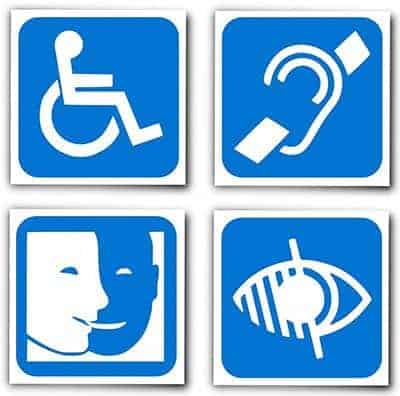The internet is an incredible place. With no effort at all, a man in Peru can begin a business with a man in Spain and meet daily face-to-face with nothing but their phones without ever having to leave the comfort of their bedroom. Education, networking, commerce, and entertainment have all been radically transformed by this remarkable breakthrough which most of us today simply take for granted. Unfortunately, for some, this miracle can be more of a curse because their particular needs are often overlooked.
This is why now, more than ever, we need to make websites accessible to all.
What is Web Accessibility?
Web accessibility is the practice of making sure everyone everywhere in any condition can make use of the miracle of the internet without hindrance, or at least getting as close as you can.

Many of the internet’s users are accompanied by temporary or permanent disabilities, or find themselves in unfavorable situations, or are browsing the web through technologies that aren’t the usual laptop browser. Whether blind, deaf, mute, faced with mobility issues, or broken arms/hands, all of your users expect to be able to interact with your website without any complications.
Likewise for your users that are in situations that are too bright for their screen, or cannot for whatever reason listen to audio or watch videos. Add to this the advancement of the Internet of Things, and you have a whole host of your users that may not have any sort of disability but are using devices that expect your website to follow a set of standards that allow them to navigate and interact with your content.
Web accessibility is the practice of smoothing out any complications in your end user’s experience by following a set of standards for web design, development, and copywriting.
Why Does Web Accessibility Matter?
Seeing as the majority of your users are likely to be without disabilities and probably interact with your website through traditional means like a browser, some may be wondering why this matters at all. Ultimately, there are five good reasons why your business should keep accessibility in mind when designing, developing, and creating content for your website: user experience, search engines, market reach, the law, and people.
User Experience
The way your users interact with your website and it’s content is a very impactful way that they interact with your brand. If their experience with your website is poor, then it will always poorly reflect on your business’s brand. Your products or services don’t sell themselves. In many ways, your content and the layout of that content does that. If the experience of adding an item to a cart is a difficult one, then your users are likely going to be discouraged from buying from you. The same is true for web accessibility. If the layout, content, or script you’re using gets in the way of your user’s actions on your website, then it will reflect poorly on your brand and your users aren’t likely to convert into paying customers.
Search Engine Optimization
In these days, user experience is a good metric for search engine optimization (SEO). Because of this and because everyone uses search engines, they’ve added web accessibility to their algorithms. It is unlikely that making your website accessible to everyone everywhere will land you among the top results, but ignoring accessibility will certainly lower your site’s listing.
Market Reach
As a business, you are likely concerned with generating revenue. In that effort, you’ve probably got a website, have developed a marketing campaign, and have taken out ads wherever you can to reach as many people as you can. It would be foolish for you to have done otherwise. But what if these people drawn by your marketing campaign arrive at your website and can’t navigate through it because your design isn’t properly marked for a screen reader? Or your ads lead a user to a landing page where the call to action is found in a video without closed captions? Without considering web accessibility, you are losing opportunities to make money for your business.
The Law
In certain cases, accessibility is required by law. Just like physical buildings are sometimes required by law to have ramps and handrails for those who may need them, websites should follow accessibility practices to be sure everyone has the same access to content, information, and opportunities. While certain laws in certain places can be unclear, it is always wiser to be safe than sorry. Make your website accessible as soon as you can to guarantee that you won’t be taken to court over it and lose a substantial amount of money.
People Matter
Most importantly of all, people matter. The visually impaired are human beings, as are those who are color blind and those with hearing difficulties. Users accessing your site through laptops or through smart devices, with a disability, with several, or with none: they are all human beings whose lives have value and are worth more than the entire world. Making your website accessible is an act of kindness to your fellow man, regardless of circumstance.

Basic Web Accessibility Tips
Now that you have an idea of what web accessibility is and its importance, let’s look at some basic things to consider when you design or hire a designer for your site and when you are creating text content.
Image Alt Text
Images are an important part of user experience on the web. They’re everywhere: in logos, banners, carousels, attached to blog posts, or to help spread out text content for easier reading. A very simple way to make your images accessible is to add Alt Text. The Alt Text of an image should describe what the user would be looking at if they were able to see the image. It also helps a search engine bot know what they’re looking at so they can list it better.
Use Semantic HTML
When designing the pages of your business website, the designer should be using HTML semantically. HTML5 has given us new and better standards for the way a website should be partitioned: a header tag for the header, a nav tag for navigation links, an article tag for an article, and more. Using these tags the way they were meant to be used will allow screen readers, keyboards, smart devices, and bots to know exactly what they’re interacting with.
Along with these semantic tags, designers and content creators should be using the heading tags appropriately. Heading tags are the H1, H2, H3, H4, H5, and H6 tags. When using these tags, make sure they are nested correctly. H1 tags are the most important titles. H2 are titles that exist between H1 tags, and so on. Styling an H3 tag to be larger than an H2 tag and giving it more importance is an inappropriate way of using these tags.
Use ARIA Attributes
Along with the above tags, HTML also gives us ARIA attributes so that we can label certain tags. ARIA stands for Accessible Rich Internet Applications. Interactivity is an important part of a user’s experience with your website. For these interactive parts, the ARIA attributes make sure that those who can’t interact with your widgets won’t be left out in the cold.
Avoid Ambiguous Link Text
One of the most common ways of using links on the internet is to direct users to another page so they can read more. The text that labels these links is usually just READ MORE. This is problematic for users and bots alike. The labels don’t tell you what they are, they are simply a command. For users that are interacting with your site in ways that require accessibility, they simply don’t know what that link would lead to. Instead, consider being explicit in your link text. If the link points to a contact page, label it CONTACT. If the page leads to an article, use the article title for the label.

Web Accessibility Tools
Accessibility can be a difficult thing to be mindful of at times, especially if you aren’t in need of it personally. So to help you make sure your website and content are accessible for all, you can make use of any of the following tools.
WAVE – Web Accessibility Evaluation Tool
With WAVE, you can type in your web address and it will evaluate how accessible your website currently is. It will show you details about what you’ve got right and what you’re getting wrong. You can use it in the browser at https://wave.webaim.org or install the Chrome or Firefox extensions.
Lighthouse
Lighthouse is an open-source project that gives web developers the ability to audit their websites. The 5 categories they test for are Performance, Accessibility, SEO, and Best Practices. Like WAVE above, after the test, you will receive a collection of actionable steps to increase your rating on any of these points.
CheckMyColors
Like the above tools, CheckMyColors allows you to input your web address and test your site. What it is auditing, in particular, is color contrast. For vision impaired persons, color contrast is very important. This test will give you a comprehensive review of different parts of your website’s color usage. With this info, you can adjust your colors until the contrast is appropriately accessible.
wA11y
This WordPress plugin called wA11y provides you with a simple way of making sure your WordPress website is accessible for all users.

Why Clio Websites
Clio Websites is a full-service website design company in Calgary. We have vast experience in responsive website design, website maintenance, WordPress development and support, and online marketing. Helping small businesses with their web design projects and online marketing needs is our specialty. Clio offers free consultations and free website evaluations. We are always available and happy to answer any questions you may have, so please contact us to find out more.
Clio offers interest-free payment plans and we receive glowing reviews from our clients. Here are a few things that set us apart from the competition. Clio Websites:
- Is a premier Calgary web design company with WordPress expertise
- Has years of experience helping small businesses achieve their online goals
- Has very high customer satisfaction and retention rates (over 98%)
- Spends the time to understand your business needs and requirements
- Prides ourselves on the quality of service we provide to each and every client
- Is responsive and won’t leave you hanging for days when you need support the most
- Creates custom websites for each project to separate you from your competition



